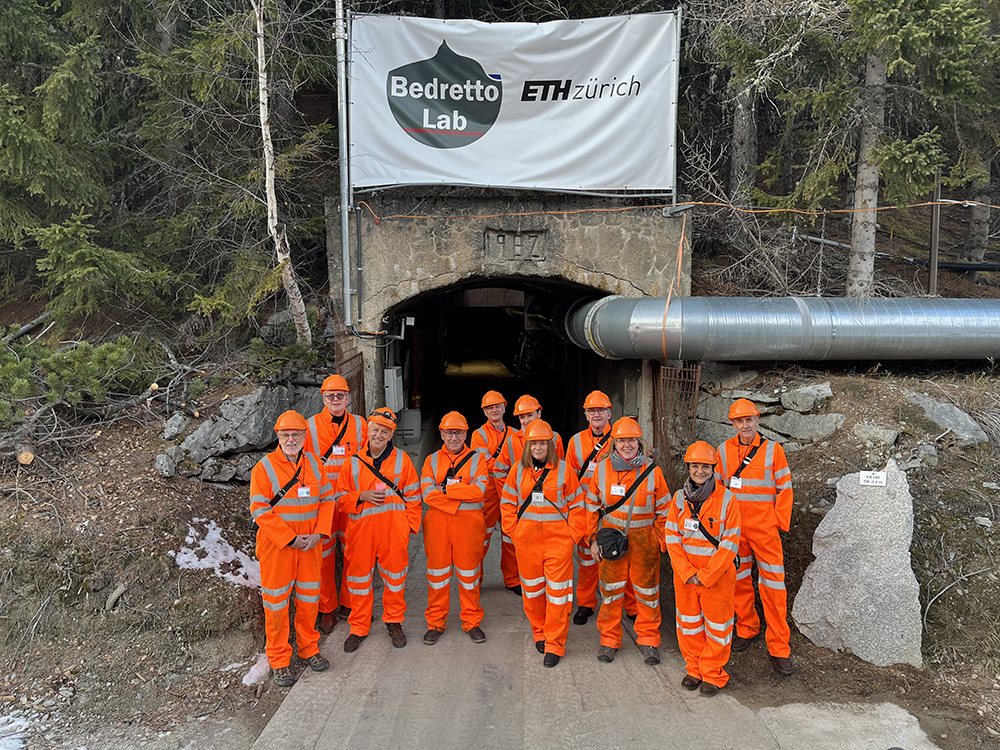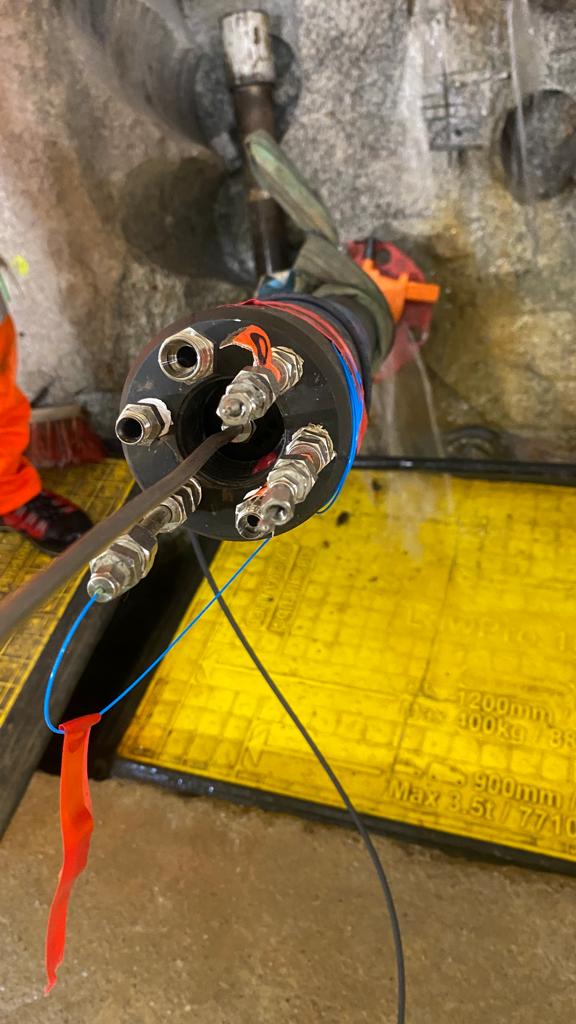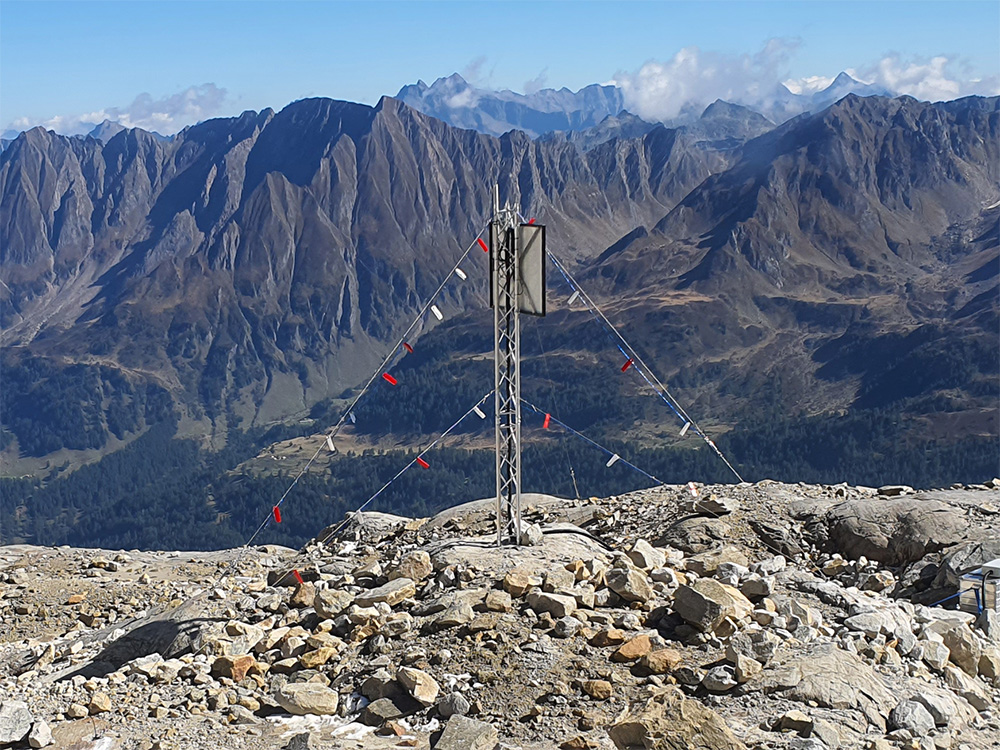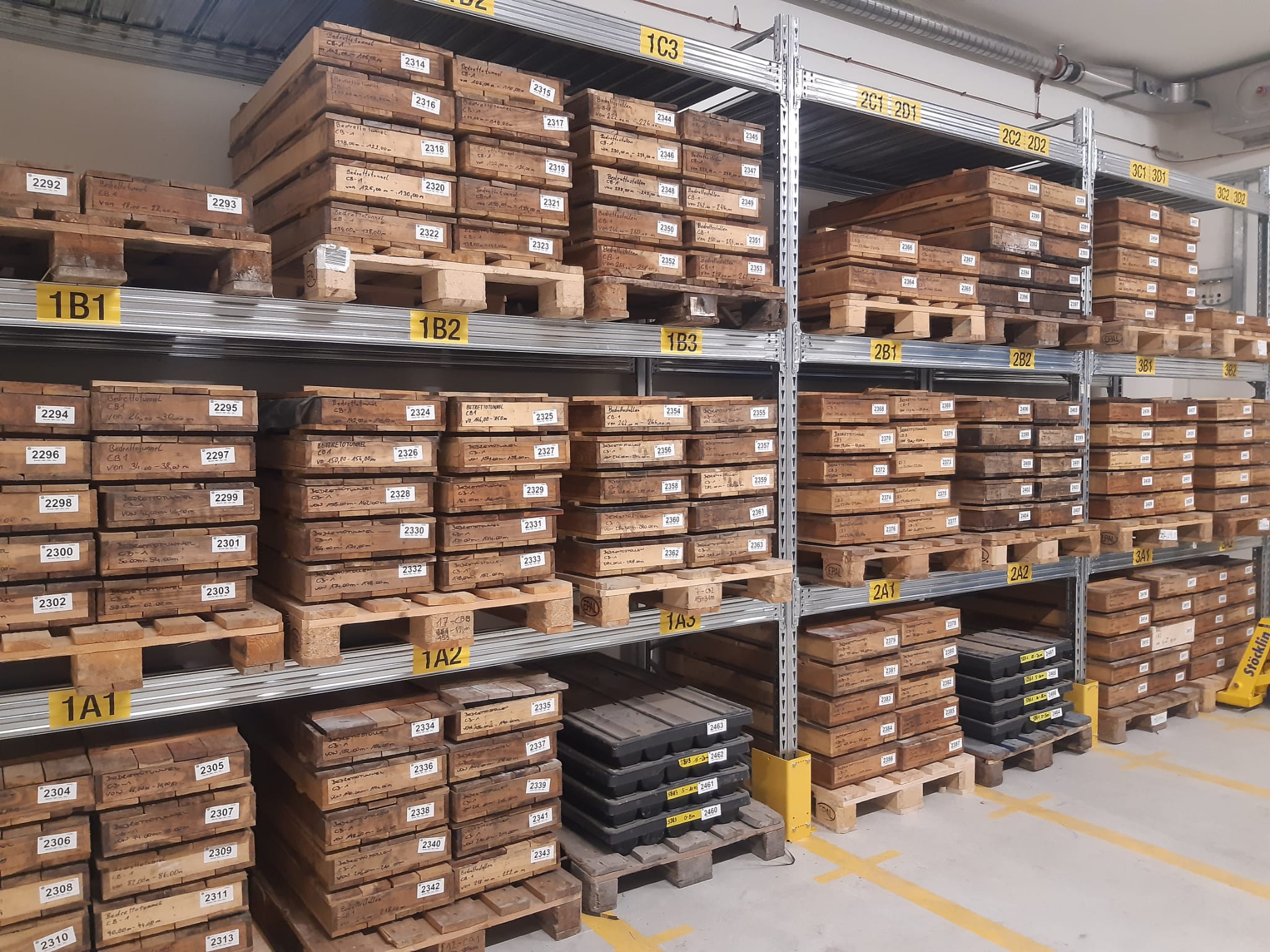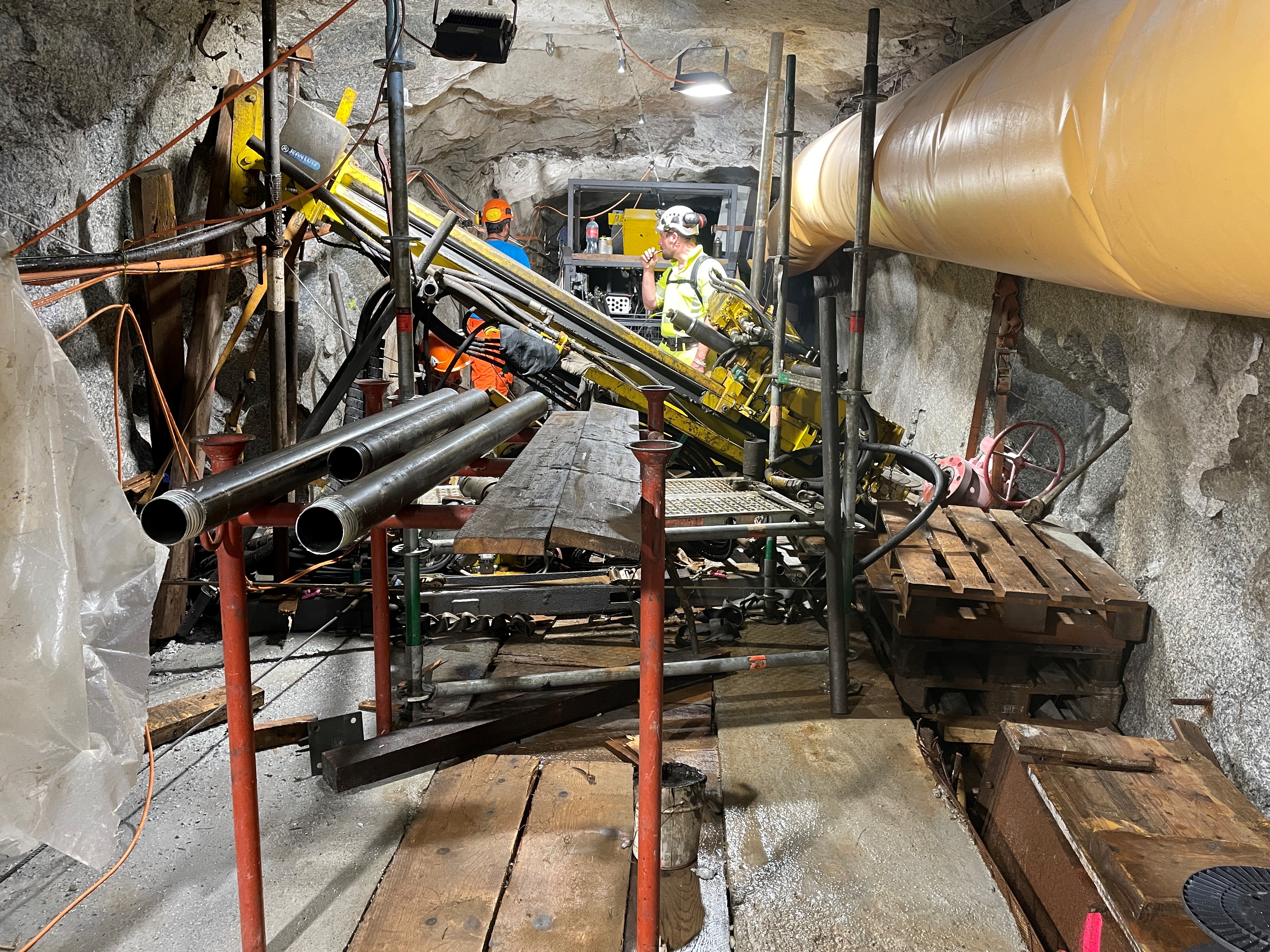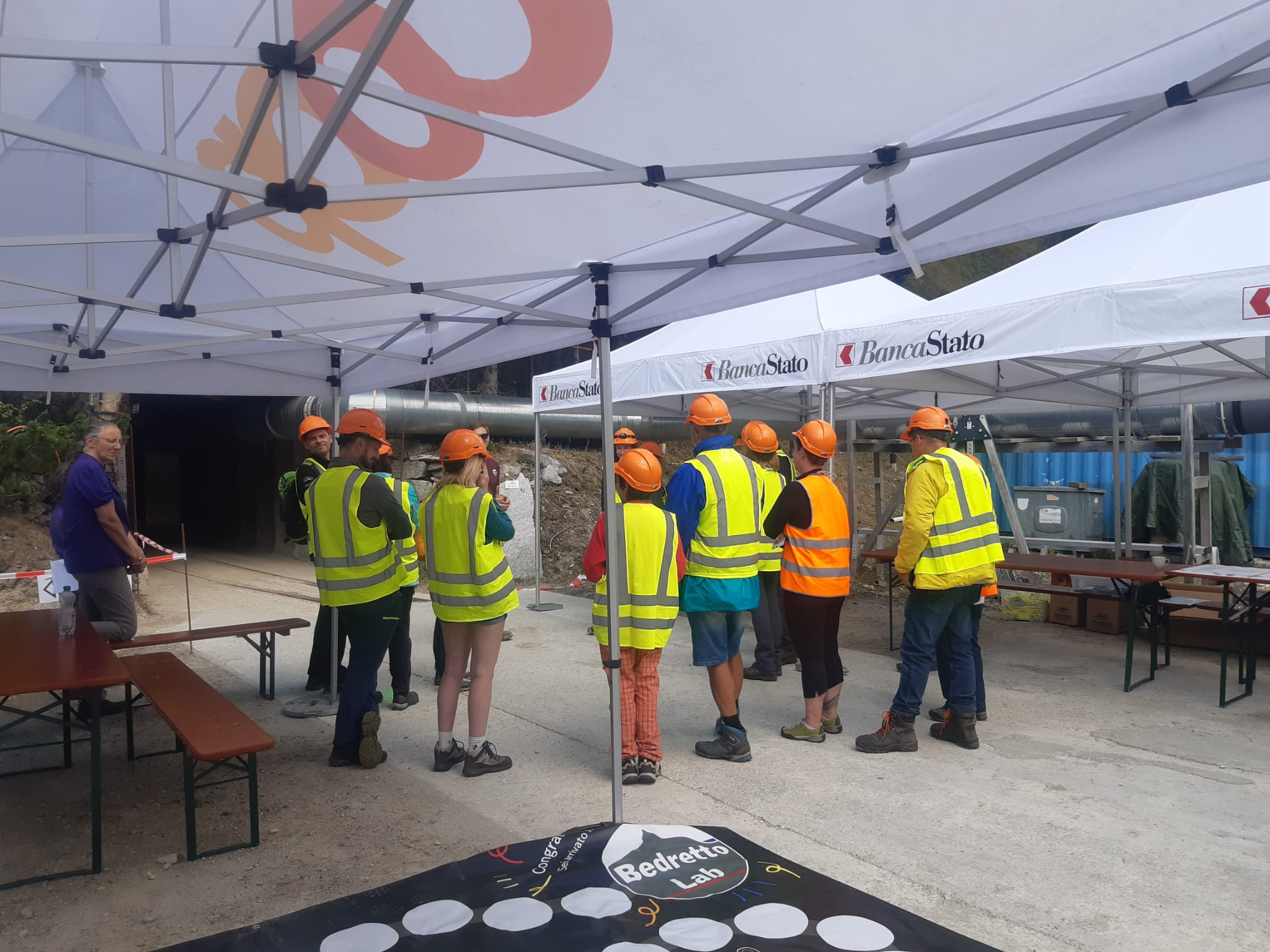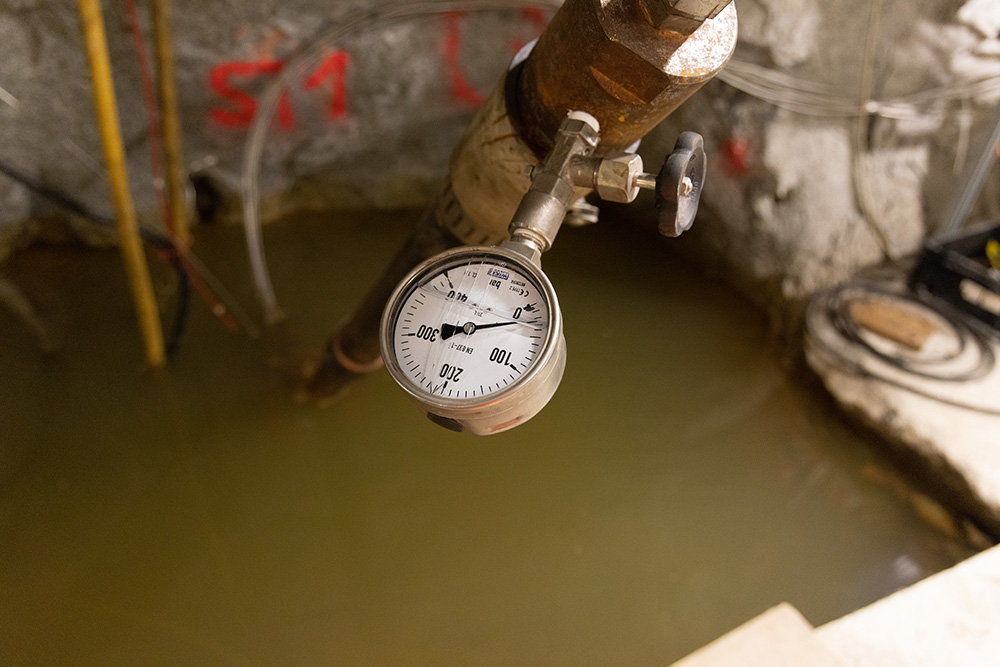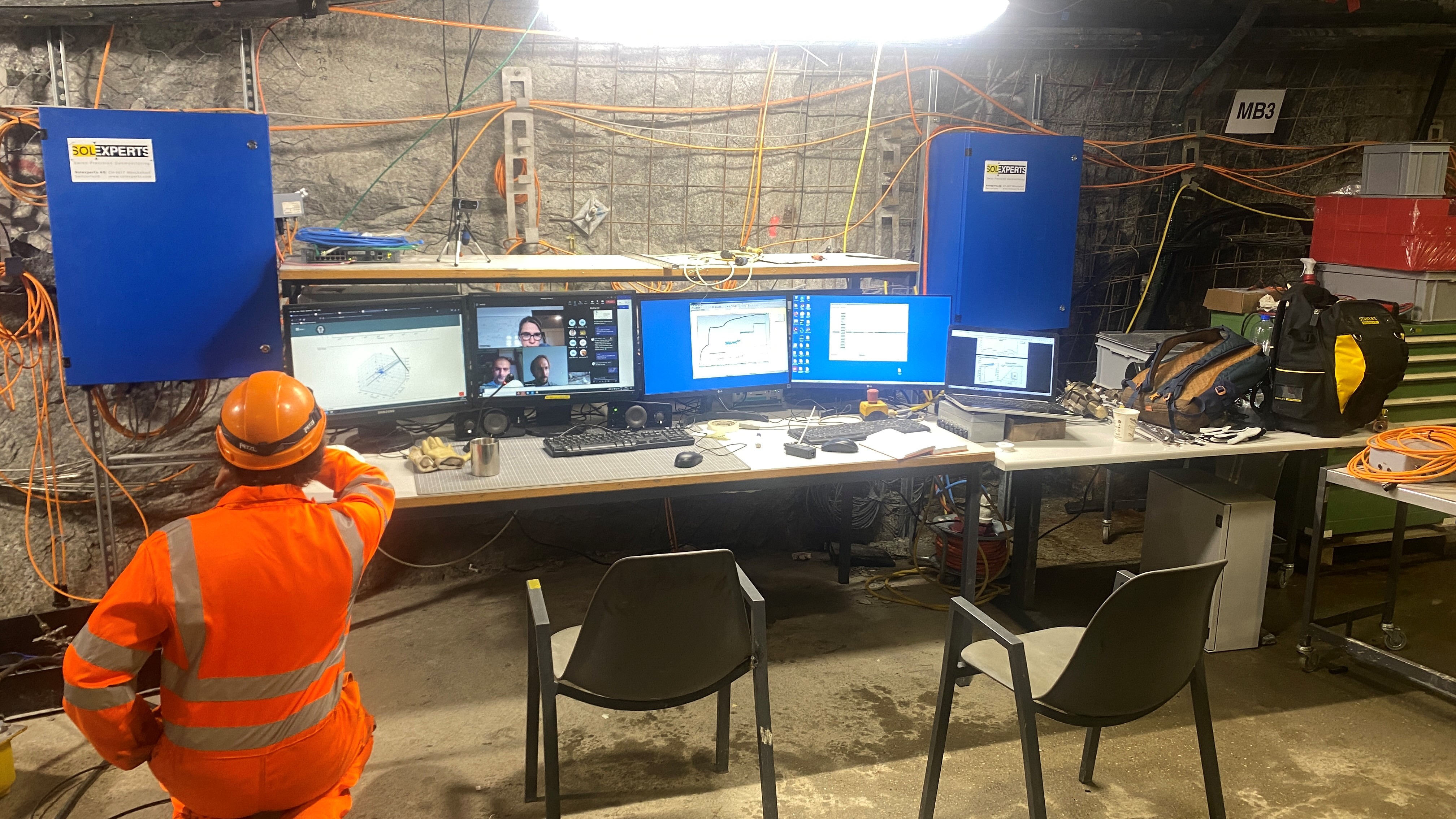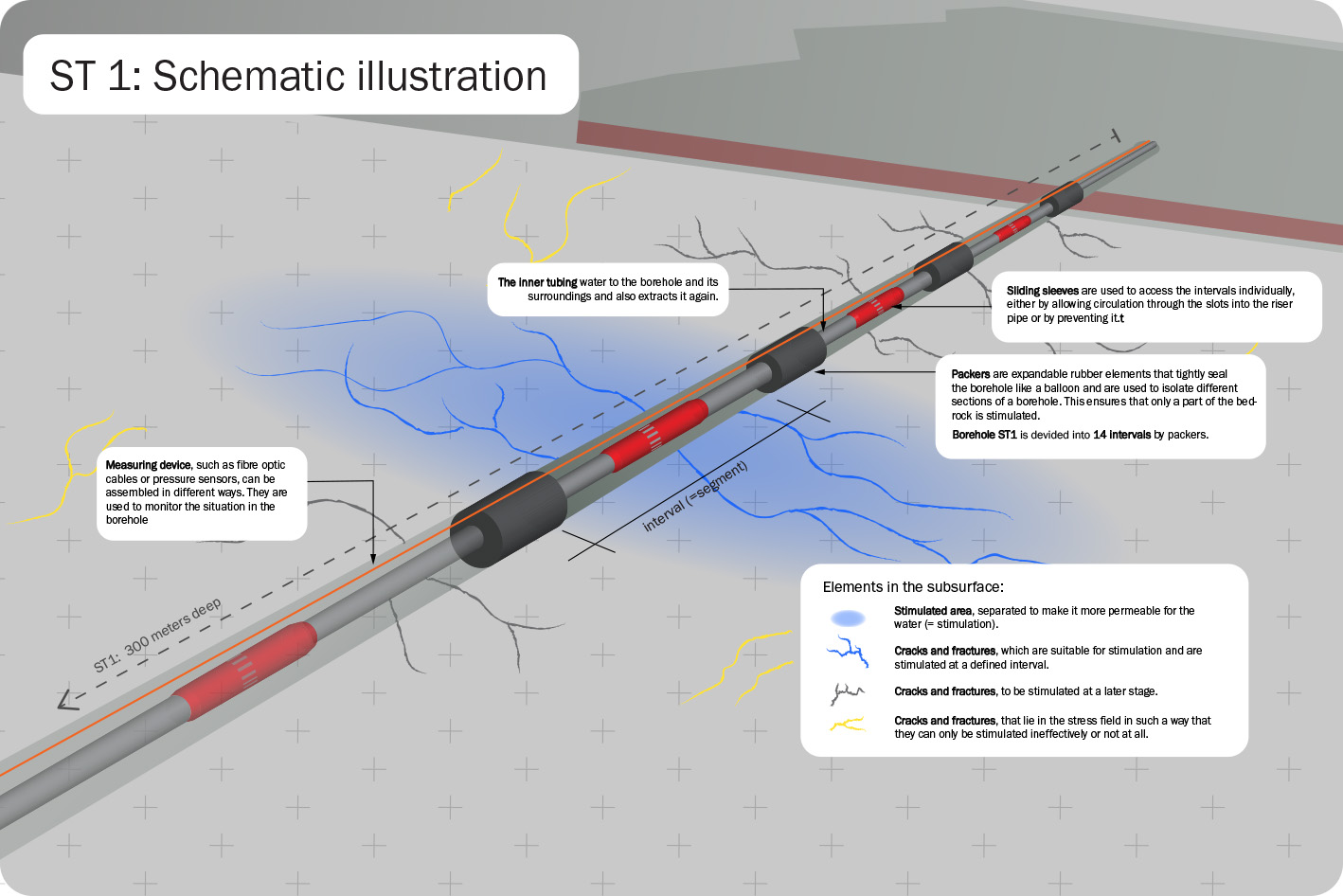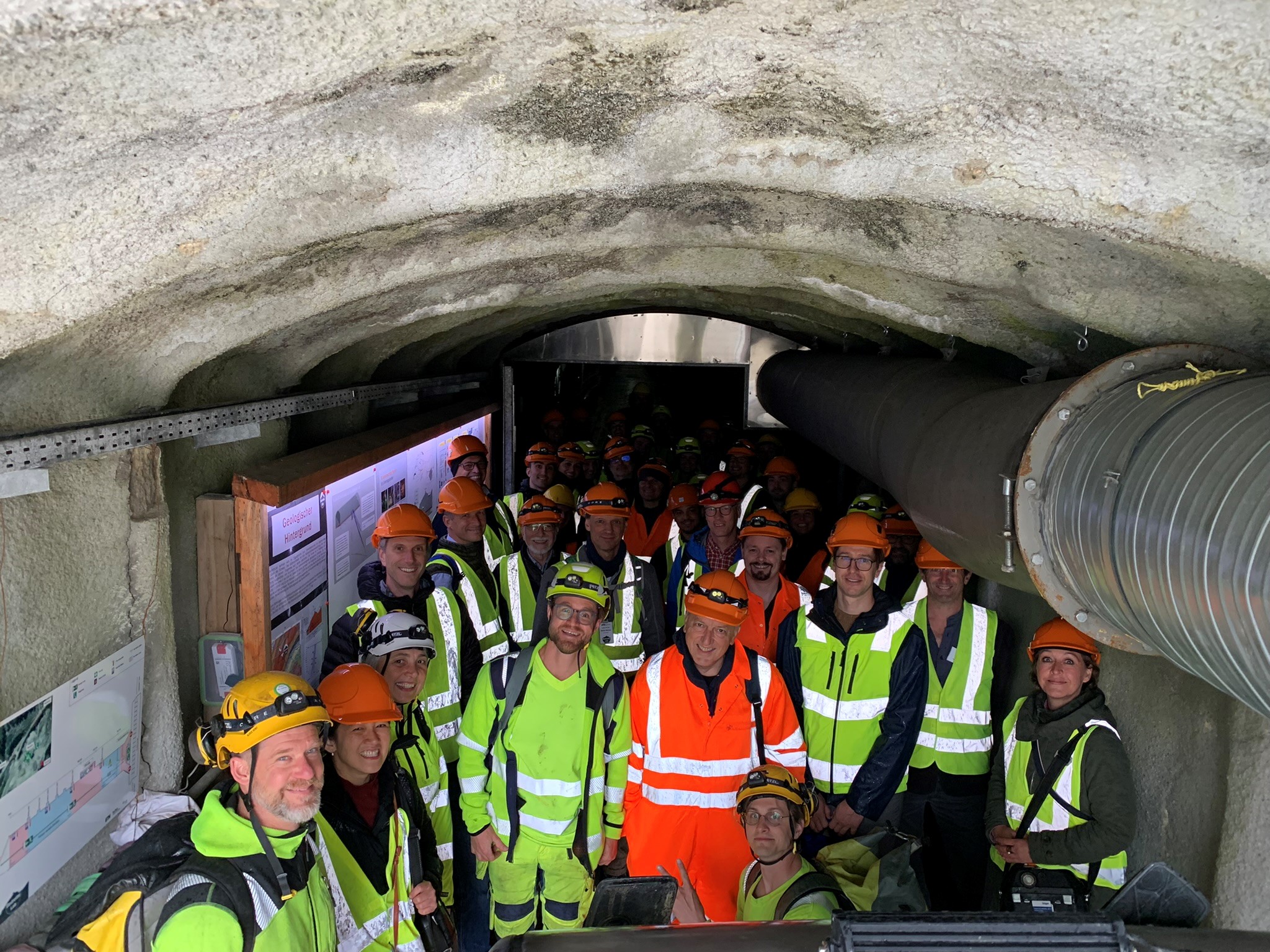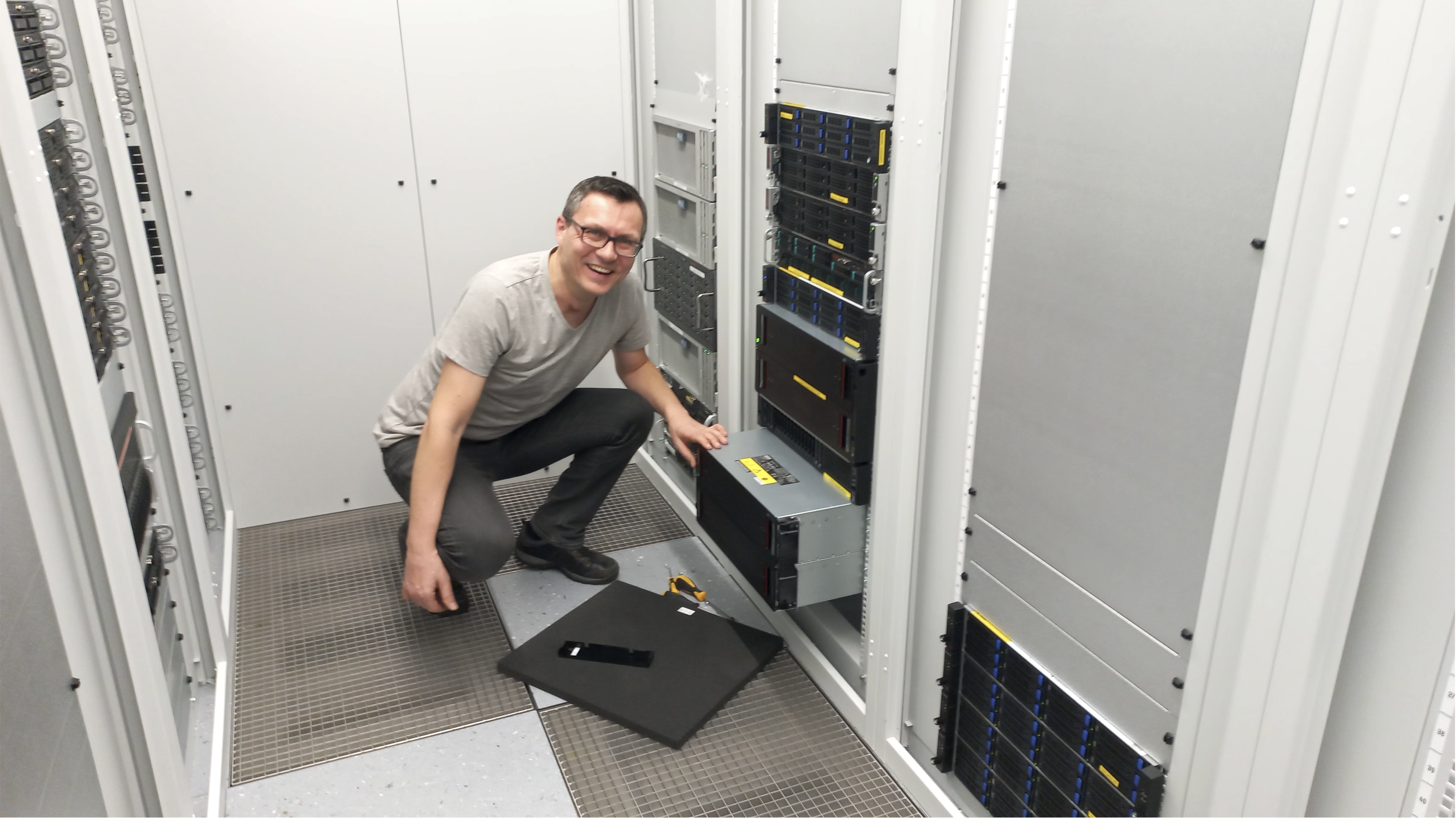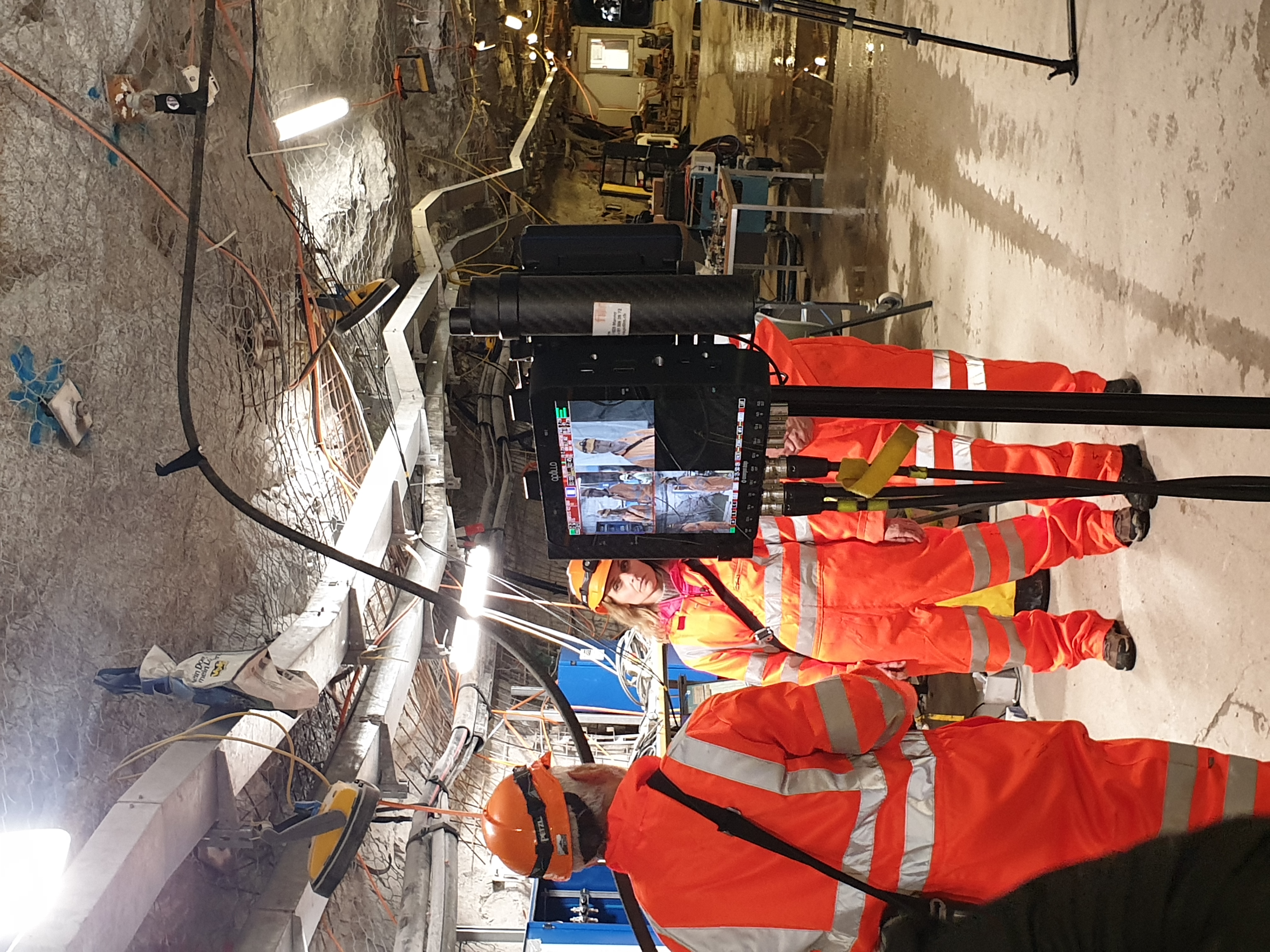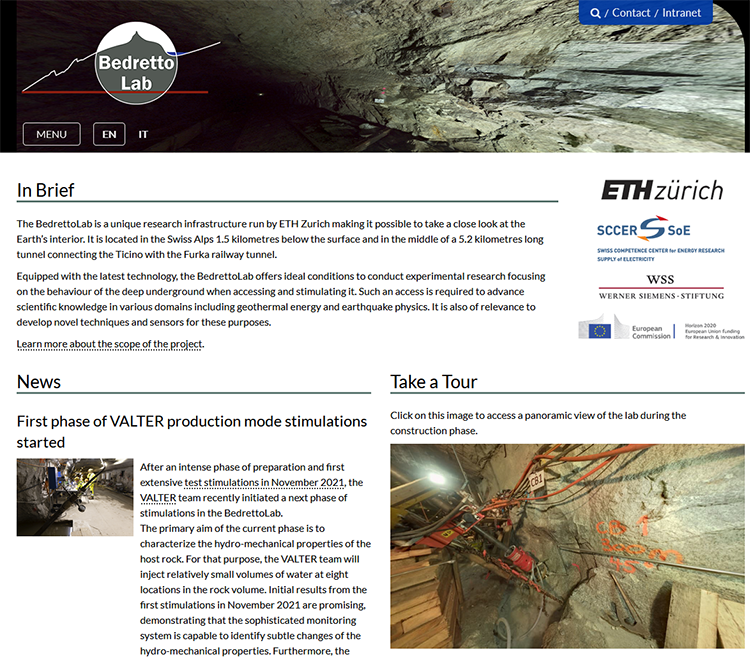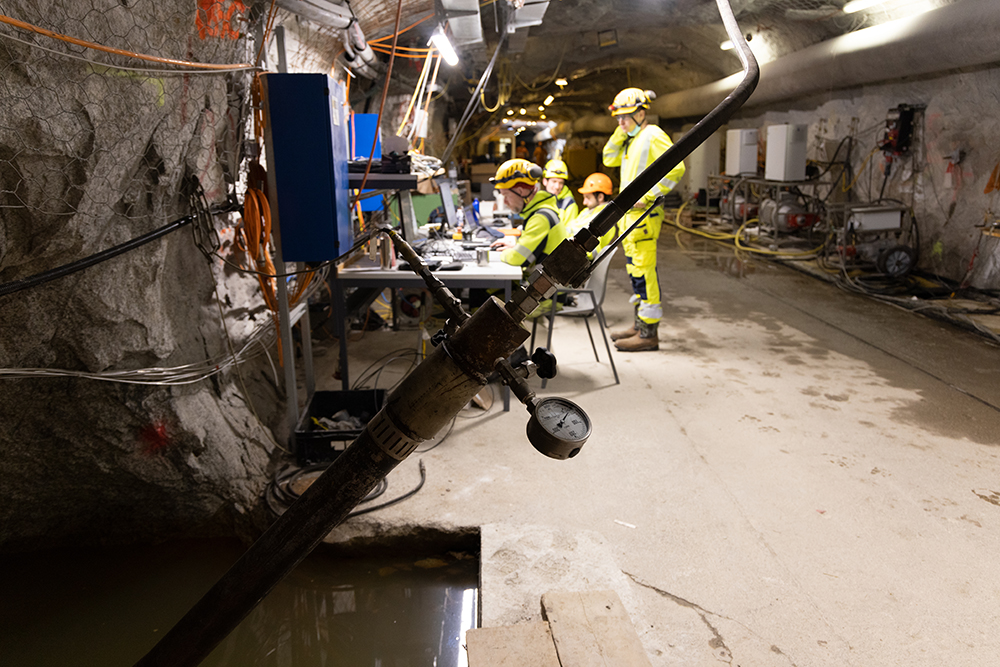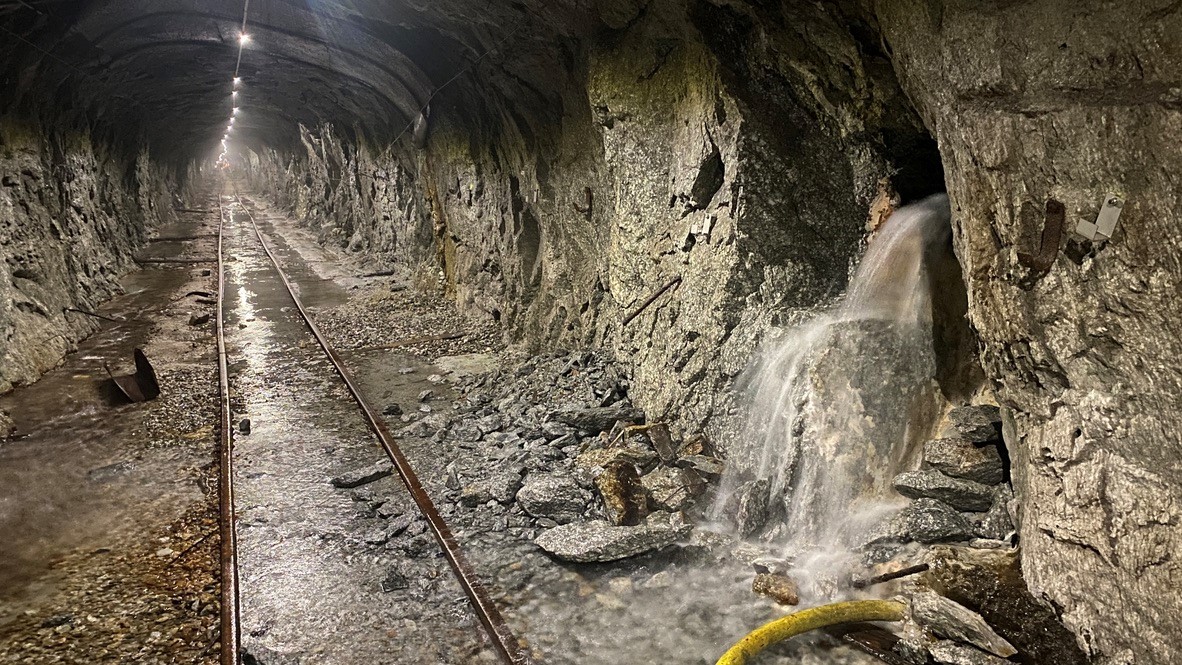2022-12-05
GEO.8 visited the BedrettoLab
Last week, the GEO.8 – European Alliance for Earth Sciences had their director’s board meeting and visited the BedrettoLab.
2022-12-01
SPINE project experiments starting this week
In the framework of the SPINE project, a team of scientists is conducting hydrotests in the BedrettoLab. These experiments aim at applying the so-called SIMFIP (Step-Rate Injection Method for Fracture In-situ Properties) probe, a device for measuring the stress state in boreholes. The key idea of the SPINE project is that a single measurement of a displacement in the borehole wall can be used to determine the overall stress. Such a displacement occurs in the micrometer to nanometer range and is caused by the injection of water. Detailed knowledge of the state of stress in the subsurface contributes to estimating the seismic risk of a deep geothermal project.
During a period of two weeks, the international SPINE team runs about ten hydrotests for approximately four hours each. Hydrotesting is the term used to describe tests in which a small amount of water is deliberately directed into small fractures found naturally along the borehole. Since only small volumes of water will be injected, the occurrence of seismic events is not expected. Nevertheless, the routine safety protocols will be applied and the experiments would be put on halt if predefined magnitude thresholds are reached.
In these experiments the water flows through the SIMFIP probe which is then able to capture millimeter to nanometer displacements of fractures affecting the borehole. Being part of a test series carried out in various laboratories, these hydrotests at BedrettoLab are contributing to the development of the SIMPFIP technology within the SPINE project. 1 December 2022
2022-11-17
New seismic station below Pizzo Rotondo installed
Members of the BedrettoLab and the Swiss Seismological Service (SED) at ETH Zurich recently installed a seismic station just 400 m beneath the Pizzo Rotondo. The new station closes an important gap in the seismic background monitoring system of the BedrettoLab. It will improve the hypocentre location estimates of earthquakes in and around the Bedretto experimental volumes.
With this latest addition, the BedrettoLab network consists now of five tunnel and three surface stations allowing to closely observe seismic activities in its surroundings. The new station is the closest surface station to the BedrettoLab; it is ~1.2km above and ~500m to the north-east of the tunnel.
The new station includes a high sensitivity and a strong motion sensor also called accelerometer. Both sensors are part of the standard equipment of seismic stations deployed by the SED. The high sensitivity sensor is capable of recording even very small seismic events (M<2), while the accelerometer is capable of measuring moderate and strong local tremors with great accuracy.
As a novelty, the seismometer has been lowered into a ~70cm deep borehole, drilled directly into the Rotondo granite. This new installation technique can potentially reduce ambient noise levels caused by e.g. wind, melt-water or rain. Because of the low noise levels even very weak seismic signals can be detected and characterised.
The new station was installed as part of the extension of the seismic background monitoring system, motivated by the Fault Activation and Earthquake Rupture project (FEAR). The project aims to investigate how earthquakes start and how they stop by initiating small, non-damaging earthquakes on a natural fault in the BedrettoLab. The FEAR monitoring system should allow to image earthquake rupture processes from unusually short distances, and with unusual detail.
2022-10-19
New rock repository for BedrettoLab
The BedrettoLab recently moved all its drill cores to a special repository site close to the city of Zurich. Here around 1,600 meters of inventoried cores from the BedrettoLab and the rock laboratory in Grimsel are stored in 662 boxes.
When drilling a borehole with a certain method, a core is extracted. Geologists and geophysicists analyse those to find out more about the stress and porosity conditions as well as about existing faults or fractures, etc. This information later helps them to characterise the surrounding rock. Also, scientists create numerical models of the rock using data drawn from core analyses.
The cores from the BedrettoLab form a geological footprint that not only support current operations but will also support future geological or geophysical research about the Rotondo massif.
2022-09-19
Drilling campaign for FEAR
The lab construction for the FEAR experiments is moving into the next phase with a major drilling campaign going on now.
All in all, three boreholes are being drilled until the end of September. The three boreholes start at tunnel metre ~2360, and we use them to verify the extension of the fault and thus the experimental design of FEAR. Additionally, the information from this prospection campaign will inform our decision about the exact starting point of the FEAR tunnel. From this new tunnel, the fault will be stimulated via injection boreholes. The first experimentation phase of the FEAR project is planned to start in summer 2023.
2022-08-08
Mangia e Cammina at the BedrettoLab
After a two year break, the local event Mangia e Cammina finally took place yesterday. For the first time, the BedrettoLab had the honor to be part of it and opened its doors once again for the public.
Mangia e Cammina attracted 1’300 visitors who hiked along a route through the Bedretto Valley, where several alps offered specialties from the region. The BedrettoLab was one destination on the Mangia e Cammina parkour and opened its doors for guided tours. Around 50 people walked additional 5 km trough the tunnel to visit the BedrettoLab. In front of the tunnel, the BedrettoLab team and several helpers from ETH Zurich and SUPSI set up several booths where visitors could play a rock game, admire a small rock and mineral exhibition, see how a seismic station works or play an entertaining “snakes & ladders” game.
The event was an excellent occasion after a longer Covid related break to show our laboratory to the public.
2022-07-18
Summer break for VALTER Phase 2
With a rich data set gathered during the two stimulation cycles of the reservoir engineering phase (Phase 2), the VALTER project team now leaves for the summer break. Further stimulations of Phase 2 are scheduled for autumn.
After having conducted experimental stimulations in June and July, the VALTER team is pausing Phase 2 until the end of the summer. This time will be used to continue analysing the wealth of data that has been gathered and also allow team members to get a rest. The VALTER team is particularly interested in gaining a better understanding of the tiny, induced earthquakes that occurred within the reservoir and further away. Such events were expected to happen, however, exploring their occurrence in more detail is exactly what is needed to advance our understanding of the behaviour of the deep underground when stimulated in the context of a geothermal reservoir.
2022-06-22
Reservoir engineering phase of the VALTER project about to start
After a short break for data analysis and planning, the VALTER team resumes with the stimulations that are part of the Bedretto Reservoir Project. This week, the next phase (Phase 2), the actual reservoir engineering phase, is going to start. The main aim is to stimulate approximately four borehole intervals for a period of up to 48 hours to create a connection between two boreholes, namely borehole ST1 and ST2.
Starting from today, the VALTER team is going to carry out hydraulic stimulations of four intervals until September 2022. In the past phase of the VALTER project, the intervals (=borehole segments) in borehole ST1 had been stimulated according to a stimulation protocol with consistent and predefined injection protocols. Based on the data from Phase 1, the fracture systems linked to the different borehole intervals were characterized and the most promising segments selected for Phase 2.
In Phase 2, approximately four intervals that turned out to be most suitable for connecting the boreholes ST1 and ST2 are going to be further enhanced. By stimulating an interval over a period of up to 48 hours, the water creates new small fractures in the rock and ideally connects the boreholes ST1 and ST2. The distance between the boreholes ST1 and ST2 is 35 meters. High-precision temperature sensors will be installed in borehole ST2. If the connection is successful, this will result in subtle changes in the temperatures measured in borehole ST2.
Hydraulic stimulations (injection of water under pressure) will enhance transmissivity through both seismic and aseismic deformation. Transmissivity is an indicator of the amount of water fractures can transmit. While more than 99% of the hydraulic energy is released without creating seismic events (aseismically), through creeping processes, we expect that again numerous tiny earthquakes will accompany the stimulation. Seismologists call earthquakes in the magnitude range -4 to -2 nanoseism.
The network installed at Bedretto is also able to detect events down to a magnitudes of -6, so called picoseism. During the upcoming Phase 2 stimulation numerous pico- and nanoseismic events are planned to be recorded again that are not only needed to create the reservoir but also represent a rich source of information on the reservoir evolution. The largest events observed during the Phase 1 stimulation was a magnitude -3. Slightly higher magnitudes are expected to be observed in Phase 2, since more water will be injected.
To make sure that the operations are safe, the injection is halted and bleed off initiated as soon as predefined safety thresholds in magnitude or vibration are reached. Besides that, the seismologists of the VALTER team are going to monitor the stimulations continuously and watch out for unusual developments.
Between the stimulations, a period of around three to four weeks is needed for data analysis. With this final phase, the scientists expect to gain insights into safe reservoir engineering on a scale that is meaningful for real-world applications, such as the geothermal project planned in Haute Sorne.
2022-05-11
First phase of VALTER stimulations completed successfully
With a series of small- to moderate-scale injections in the anticipated VALTER reservoir, key physical properties of the host rock have been investigated. The experiments led to a comprehensive data set, which is currently being analysed by the VALTER Team. The results will form the basis for the next phase of the project, in which a proxy of a geothermal reservoir will be created.
Since February 2022, the multidisciplinary VALTER Team, including roughly 15 researchers as well as engineers and technicians of various backgrounds, worked on a tight schedule to carry out the first suite of multi-stage stimulations of the VALTER project. This stimulation concept is a unique approach, in which a borehole is divided by packers into several segments that can be stimulated separately. Following this methodology, which has been developed and tested at some intervals in the BedrettoLab by Geoenergie Suisse within the Destress project, specific fracture systems can be targeted and characterized in more detail. Additionally, multi-stage stimulations may minimise the level of induced seismicity.
Hydrotests and stimulations
The stimulations were carried out in borehole ST1 (s. image) and set up to obtain more insights on the fractured rock mass and its transmissivity. From the 14 intervals within ST1, nine intervals were probed (the remaining five intervals were stimulated earlier in the framework of Destress). The tests included initial hydrotests, followed by the actual stimulations and another hydrotest after the completion of the stimulations. During the stimulations, water was injected in a controlled fashion into a specific interval, and the resulting pressure, temperature and deformation changes, as well as induced seismicity, were monitored with a dense network of sensors.
Seismicity wanted
Besides acquiring hydraulic and hydromechanical data, a real time-monitoring of the seismicity is essential for such experiments, because the injected water is not only flowing through pre-existing fractures but also creates new fractures of various sizes that then help to enhance the reservoir transmissivity. The latter is required for creating a reservoir and therewith the exploitation of geothermal energy. This process is also associated with induced seismicity. During the VALTER stimulations, seismic events of moment magnitudes ranging from -6 to -3 occurred. These earthquakes are way too small to be felt and can only be measured by very sensitive instruments. However, this seismicity is an essential diagnostic tool during the reservoir creation process, and such small events are thus welcome. In order to avoid earthquakes of larger magnitudes that could be felt or put anyone into danger, a so-called traffic light system has been put into place. When predefined thresholds would be reached and detected by the monitoring system, ongoing procedures would immediately be put on halt. During this first phase of VALTER, none of the experiments triggered events that would have required any change of the injections.
Data analyzation and preparation
First data analyses are currently underway. Initial results show a large variety of the hydraulic, hydromechanic and seismic behaviour of the rock mass volume during the stimulations. For example, some intervals exhibit strong seismic response but little hydraulic changes, whereas other intervals show the opposite. The VALTER team is currently establishing conceptual models that are compatible with all these observations. These models will be of great importance for the next phase of the VALTER project, in which a proxy of a geothermal reservoir should be generated. Here, the most promising structures will be stimulated with larger injections that may extend over longer periods.
A multidisciplinary effort
The complexity of the experimental setup and the multidisciplinary nature of the VALTER project required substantial coordination efforts. Efficient communication between the individual research disciplines and with the technical staff proved to be essential. Here, the project benefitted from the excellent infrastructure in the BedrettoLab. The entire monitoring network is connected to a fast internet connection. This enabled seamless interactions between the onsite team and the various experts located at ETH Zurich. The individual data streams could be checked in real time, and, when necessary, decisions on adjustments of the procedures could be taken very quickly.
The Bedretto Reservoir Project
The currently running VALTER project is part of the Bedretto Reservoir Project, which is an umbrella project for VALTER, Destress and ZoDrEx. While having the complementary targets, the three projects test and develop different techniques for the creation of a test reservoir. In this context, VALTER and Destress investigate the enhancement of the stimulation processes. Thereby, DESTRESS mainly focused on the proof of concept of the multi-stage stimulations whereas VALTER is monitoring the processes in the rock more densely and over a longer period of time. ZoDrEx focuses on the improvement of drilling efficiency, zonal isolation technologies and development of instrumentation for geothermal energy plants.
2022-05-05
FEAR annual meeting 2022
The FEAR Annual Meeting took place in Airolo and Bedretto this week. The team of almost 50 participants from ETH Zürich, RWTH Aachen, and INGV Rome gathered to share their results and discuss the next steps of the project.
The meeting focused on preparing for FEAR the first experiment. A lot of things need to be done to get there. Boreholes have to be drilled, prospection campaigns carried out, a tunnel designed and constructed, monitoring systems designed and optimized, rock samples have to be tested in the lab, numerical models calibrated, parameter values and their uncertainties estimated, a real-time traffic-light risk mitigation system and remote control for safe operation of the experiment implemented.
The last few days were spent with lively discussions and in-depth breakout sessions on who will do what and when, so that one year from now, we can push the button. After all the hard work, some fun and games were in order. There was a visit to the BedrettoLab with dinner and a concert.
2022-04-19
FEAR project website online
The website for the Fault Activation and Earthquake Rupture ('FEAR') project is now online. The goal of FEAR is to improve our understanding of earthquake physics, by densely instrumenting and then stimulation an existing, natural fault. The small earthquakes resulting from this stimulation shall provide new insights on how earthquakes originate and evolve. Again, safety is our first priority and the measures taken to ensure safe procedures are described on this page.
The construction work for the new FEAR experimental setup is ongoing. The experiment is situated about 2.5 km and therewith 400 meters beyond the currently used lab at the Bedretto tunnel. Recently, first boreholes have been drilled. They will be instrumented and serve to determine if there is any seismic background activity in the experimental volume, and whether the selected target structure - a north-west dipping natural fault zone with evidence of past seismic activity - is large enough to host the FEAR experiments.
Please check the website to find detailed information about FEAR: http://fear-earthquake-research.org
2022-03-28
The backbone of experiments: Fiber optic cables & data storage
In addition to the sophisticated sensor network, a large network of fiber optic cables and ultimately data storage, forms the backbone of our research lab. Recently, another 1.2 petabytes of storage has been installed at the ETH Zurich.
Constantly, 800 MB of data per day are being sent from the acoustic emission sensors in the BedrettoLab to the servers in Zurich. On top of that, up to 1TB per day from the ongoing experiments, measured by sensors such as fiber optics interrogators, geophones, temperature, pressure and strain meters, are stored in the raw time series archive. This is a central access point for all data together with consistent timing information. For the researchers, this is the key for any type of synoptic interpretation, e.g. seismic event detection.
2022-03-07
Il giardino di Albert at BedrettoLab
Recently, we had the honour of welcoming a TV crew of RSI, who shot an episode of the science show “Il giardino di Albert”. Two moderators interviewed Prof. Domenico Giardini, board member of the BedrettoLab, who explained the scope of our research activities and presented the lab infrastructure.
The episode of “Il giardino di Albert” provides you with a comprehensive insight into the underground laboratory and can be watched here. The program is in Italian.
2022-02-10
First phase of VALTER production mode stimulations started
After an intense phase of preparation and first extensive test stimulations in November 2021, the VALTER team recently initiated a next phase of stimulations in the BedrettoLab.
The primary aim of the current phase is to characterize the hydro-mechanical properties of the host rock. For that purpose, the VALTER team will inject relatively small volumes of water at eight locations in the rock volume. Initial results from the first stimulations in November 2021 are promising, demonstrating that the sophisticated monitoring system is capable to identify subtle changes of the hydro-mechanical properties. Furthermore, the associated seismic activities can be well characterized down to magnitudes of -6. The largest events happening during the stimulations reached magnitudes of about -4.6. To have a comparison: Usually earthquakes can be felt from a magnitude of 2.5 on, which is about 45 billion times stronger than a magnitude of -4.6.
The current phase of stimulations is expected to be completed in late spring. For the following phase, the VALTER team will design stimulation protocols appropriate to permanently enhance the transmissivity of the rock volume and create an experimental geothermal reservoir structure. This step is expected to be completed in summer 2022. Again, safety is top priority and ensured by several safety layers. Further information is available in the last news article featuring the VALTER stimulations.
2022-01-31
Extension of the BedrettoLab has started
The BedrettoLab entered a new phase in November 2021 (see news article), in which the Lab is being extended to include a second testbed. The first step of the retrofitting has been completed, including the installation of electricity and lighting to 2900 TM (TM = tunnel meter).
In the following weeks, the ventilation ducts will be extended to 2900 TM and we will begin the first phase of cementing the tunnel passage. Then a series of boreholes will be drilled, one set for long term seismic monitoring and another for geologic exploration of the second testbed. These will be completed late Summer 2022. Afterwards, a second phase of construction will finalize the road extension to 3050 TM and complete additional safety reinforcements in the latter part of the tunnel.

